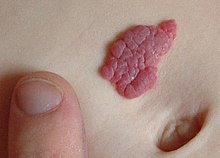User:Mr. Ibrahem/Infantile hemangioma
| Infantile hemangioma | |
|---|---|
| Other names | Infantile haemangioma, emangioma, capillary hemangioma, capillary angioma, juvenile [1] |
 | |
| A small hemangioma of infancy | |
| Specialty | Dermatology, gastroenterology |
| Symptoms | Raised red or blue lesion[2] |
| Complications | Pain, bleeding, ulcer formation, heart failure, disfigurement[1] |
| Usual onset | First 4 weeks of life[1] |
| Types | Superficial, deep, mixed[1] |
| Risk factors | Females, white people, preemies, low birth weight babies[1] |
| Diagnostic method | Based on symptoms and appearance[1] |
| Differential diagnosis | Congenital hemangioma, pyogenic granuloma, kaposiform hemangioendothelioma, tufted angioma, venous malformation[1] |
| Treatment | Close observation, medication[1][3] |
| Medication | Propranolol, steroids[1][3] |
| Frequency | Up to 5%[3] |
An infantile hemangioma (IH) is a type of benign vascular tumor that affects babies.[1] They appear as a red or blue raised lesion.[2] Typically they begin during the first four weeks of life, grow until about five months of life, and then shrink in size over the next few years.[1] Often skin changes remain following involution.[1][3] Complications may include pain, bleeding, ulcer formation, heart failure, or disfigurement.[1]
The underlying reason for their occurrence is not clear.[1] In about 10% of cases they appear to run in families.[1] A few cases are associated with other abnormalities such as PHACE syndrome.[1] Diagnosis is generally based on the symptoms and appearance.[1] Occasionally medical imaging can assist in the diagnosis.[1]
In most cases no treatment is needed, other than close observation.[1][3] Certain cases, however, may result in problems and the use of medication such as propranolol or steroids are recommended.[1][3] Occasionally surgery or laser treatment may be used.[1]
It is one of the most common benign tumors in babies, occurring in about 5%.[1][3] They occur more frequently in females, white people, preemies, and low birth weight babies.[1] The word "hemangioma" comes from the Greek haima (αἷμα) meaning "blood"; angeion (ἀγγεῖον) meaning "vessel"; and -oma (-ωμα) meaning "tumor".[4]
References
[edit]- ^ a b c d e f g h i j k l m n o p q r s t u v w Darrow, DH; Greene, AK; Mancini, AJ; Nopper, AJ (October 2015). "Diagnosis and Management of Infantile Hemangioma". Pediatrics. 136 (4): e1060-104. doi:10.1542/peds.2015-2485. PMID 26416931.
- ^ a b "Infantile Hemangiomas". Merck Manuals Professional Edition. Archived from the original on 2 March 2021. Retrieved 7 January 2019.
- ^ a b c d e f g Krowchuk, DP; Frieden, IJ; Mancini, AJ; Darrow, DH; Blei, F; Greene, AK; Annam, A; Baker, CN; Frommelt, PC; Hodak, A; Pate, BM; Pelletier, JL; Sandrock, D; Weinberg, ST; Whelan, MA; SUBCOMMITTEE ON THE MANAGEMENT OF INFANTILE, HEMANGIOMAS. (January 2019). "Clinical Practice Guideline for the Management of Infantile Hemangiomas". Pediatrics. 143 (1): e20183475. doi:10.1542/peds.2018-3475. PMID 30584062.
- ^ Lexicon Orthopaedic Etymology. CRC Press. 1999. p. 16. ISBN 9789057025976. Archived from the original on 2019-01-08. Retrieved 2019-01-07.
